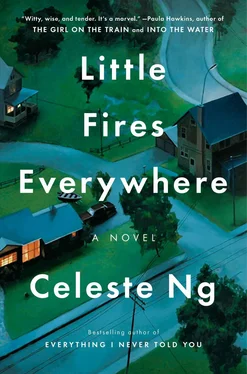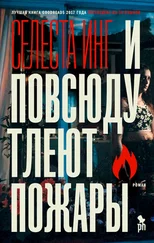When she rang the Wilkinsons’ doorbell, Mrs. Wilkinson led her into the den, where Mr. Wilkinson sat at a large desk typing something on a cream-colored typewriter. But when Mia entered, he swiveled around in his chair and swung the typewriter shelf down and under, where it folded into a cabinet in the desk as neatly as if it had been swallowed.
“Now then,” he said. He unfolded a pair of half-moon glasses that hung around his neck and placed them on his nose, and Mia’s knees trembled. “Let’s have a look.”
Mr. Wilkinson, it turned out, was a photographer himself—though he preferred landscapes. “Don’t like shots with people in them,” he told her. “I’ll take a tree over a person any day.” When he went on a trip, he took his camera with him and always scheduled himself half a day to go exploring. From a file he pulled a stack of photographs: a redwood forest at dawn, a river snaking through a field shot with dew, a lake reflecting the sun in a glittering triangle that pointed to the woods beyond. The photographs all over the hallway, Mia realized, were his as well.
“You’ve got a good eye,” Mr. Wilkinson said at last. “Good eye and good instincts. See this one here?” He tapped the top picture, a photo of Warren perched in the low branches of a sycamore, back to the camera, silhouetted against the sky. “That’s a fine shot. How’d you know how to frame that?”
“I don’t know,” Mia admitted. “It just looked right.”
Mr. Wilkinson squinted at another. “Hold on to that. Trust your eyes. They see well.” He plucked out another photo. “But see this? You wanted that squirrel, didn’t you?” Mia nodded. It had been running along the ridge of the fence and she’d been mesmerized by the undulating arc its body and tail had traced as it ran. Like watching a ball bounce, she’d thought as she clicked the shutter. But the photo had come out blurry, focused on the fence instead of the squirrel, the squirrel itself simply a smudge. She wondered how Mr. Wilkinson knew.
“Thought so. You need a better camera. That one’s fine for a starter, or for birthday parties and Christmas. Not for you.” He went to the closet and rummaged in the back, the old overcoats and bagged dresses inside muffling his voice. “You—you want to take real pictures.” In a moment he returned and held out a compact box. “You need a real camera, not a toy.”
It was a Nikon F, a little silver-and-black thing, heavy and solid in her hands. Mia ran her fingers over the pebbled casing. “But I can’t take this.”
“I’m not giving it, I’m lending it. You want it or not?” Without waiting for her to answer, Mr. Wilkinson opened a drawer in his desk. “I’m not using that one anymore. Someone might as well.” He removed a black canister of film and tossed it to Mia. “Besides,” he said, “I’m looking forward to seeing what you do with it.”
By the time Mia went home that afternoon, she had learned how to wind the film onto the spool inside the camera, how to focus it, how to adjust the lens. Strange and beguiling new words swirled in her head: f-stop, aperture. Over and over again she lifted the camera to her eye to peer through the viewfinder. Under the hairline cross at its center, everything was transformed.
Mr. Wilkinson taught her how to extract the film from its roll and develop it, and Mia came to love the sharp bite of the developer, how to watch for the sheen of silver on the film’s surface that told her it was ready. Like a pilot dipping the plane into a tailspin to practice pulling back out, she would deliberately take photos out of focus, with the wrong shutter speed or the wrong ISO, to see what happened. She learned how to control the light and the camera to get the effects she wanted, like a musician learning the intricacies of an instrument.
“But how can you—?” she would ask, watching the print form on the paper and comparing it to the image she’d had in her mind. At first Mr. Wilkinson would know the answer. “Dodging.” “Use a diffused bright fill.” “Let’s try freelensing.” But soon her questions became more advanced, sending him to the copy of Photographic Techniques he kept on the bookshelf.
“The young lady wants a greater depth of field,” he mused one afternoon. By now Mia was fifteen. “What the young lady needs is a view camera.”
Mia had never heard of such a thing. But soon all her earnings, from clerking at Dickson’s Pharmacy to waitressing at the Eat’n Park, were earmarked for a camera, and she spent hours poring over Mr. Wilkinson’s camera catalogs and photography magazines.
“You spend more time reading those things than you do taking pictures,” Mr. Wilkinson teased her, but she eventually settled on one—the Graphic View II—and even Mr. Wilkinson couldn’t dispute her choice.
“That’s a solid camera,” he said. “Good value for your money. You take care of that, it’ll be with you your whole life.” And when the Graphic View II arrived, procured secondhand from a classified ad, well loved and packed into its own case like an expensive violin, Mia knew this would be true.
To her parents the camera was less impressive. “You spent how much on that?” her mother asked, while her father shook his head. It looked, to them, like something from the Victorian era, balanced on a spindly tripod, with a pleated belly like a bellows and a dark cloth that Mia ducked underneath. She tried to explain to them how it worked, but at the first mention of shifts and tilts their attention began to wander. Even her beloved Warren gave up at that point—“I don’t need to know how it works, Mi,” he told her at last, “I just want to see the pictures”—and Mia realized that she was crossing into a place she would have to go alone.
She took pictures of the jungle gym at the local park, of streetlights at night, of city workers chopping down an oak that had been struck by lightning. She lugged the view camera downtown to photograph a rusty bridge stretching over the spot where the three rivers collided. By toying with the settings, she took a picture of Warren’s football game, from up in the bleachers, where the players looked like miniatures, the kind you’d see on a train set. “That’s me?” Warren had said, peering at one of the figures, the one long in the end zone, waiting for the pass. “That’s you, Wren,” Mia said. She had a sudden image of herself as a sorceress, waving her hand over the field and transforming the boys below into pea-sized plastic dolls.
She took that print to Mr. Wilkinson’s the next day, only to find a strange woman at the door. Mr. Wilkinson’s daughter-in-law, it turned out. “Della passed in her sleep,” the daughter-in-law told her, eyeing Mia, the camera around her neck, the photograph in her hand. “What did you say you needed?” After the funeral, the daughter-in-law and her husband convinced Mr. Wilkinson to move into a retirement home in Silver Spring, nearer to them. It happened so quickly Mia did not even have the chance to say good-bye, let alone show him the photograph, and she and her camera were alone again.

In the fall of 1979, her senior year of high school, Mia applied to the New York School of Fine Arts with a series of photographs she’d taken of abandoned buildings around town. She’d dabbed the prints with a damp cloth and, while the emulsion was wet, used the tip of a needle to scrape away the image, leaving a pin-thin white line. The results were a kind of reverse scrimshaw: a spectral worker slumped on the steps outside a shuttered factory; the outline of a sedan atop the empty hydraulic lift of Jamison’s Auto Repair; a pair of phantom children scrambling hand in hand up a hill of slag. At the sight of those children, Warren had squinted and peered closer. The two children could have been anyone, but they weren’t anyone: there was the little cowlick at the crown of Warren’s head, there was the knotted silk scarf around Mia’s neck, the weight of the camera pulling her slightly askew. There were no pictures of the two of them doing such a thing but it seemed to them they’d spent their childhoods playing on the slag heaps that butted up against the park, and looking at his sister’s photograph, Warren felt as if Mia had taken a photo of the ghosts of their past selves, about to fade into the ether. “When you get it back, can I have it?” he’d asked.
Читать дальше













